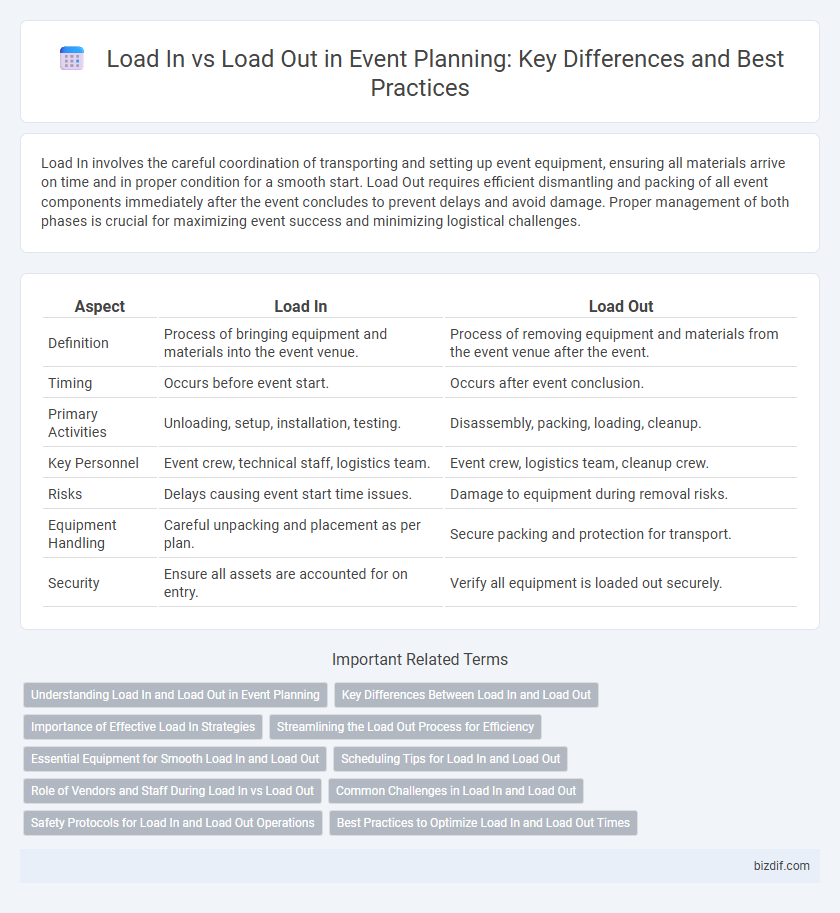Load In involves the careful coordination of transporting and setting up event equipment, ensuring all materials arrive on time and in proper condition for a smooth start. Load Out requires efficient dismantling and packing of all event components immediately after the event concludes to prevent delays and avoid damage. Proper management of both phases is crucial for maximizing event success and minimizing logistical challenges.
Table of Comparison
| Aspect | Load In | Load Out |
|---|---|---|
| Definition | Process of bringing equipment and materials into the event venue. | Process of removing equipment and materials from the event venue after the event. |
| Timing | Occurs before event start. | Occurs after event conclusion. |
| Primary Activities | Unloading, setup, installation, testing. | Disassembly, packing, loading, cleanup. |
| Key Personnel | Event crew, technical staff, logistics team. | Event crew, logistics team, cleanup crew. |
| Risks | Delays causing event start time issues. | Damage to equipment during removal risks. |
| Equipment Handling | Careful unpacking and placement as per plan. | Secure packing and protection for transport. |
| Security | Ensure all assets are accounted for on entry. | Verify all equipment is loaded out securely. |
Understanding Load In and Load Out in Event Planning
Load In and Load Out refer to the critical phases in event planning involving the movement of equipment and materials; Load In is the process of bringing in all necessary items to set up the event, while Load Out involves the organized removal of all equipment post-event. Efficient coordination of Load In ensures timely setup, minimizing delays and allowing for thorough preparation. Effective Load Out planning reduces venue downtime, helps avoid additional charges, and ensures safety during the teardown process.
Key Differences Between Load In and Load Out
Load in involves the organized arrival and setup of equipment, materials, and staff before an event begins, focusing on timely delivery and placement to ensure smooth execution. Load out refers to the systematic breakdown, packing, and removal of equipment and materials immediately after the event concludes, prioritizing efficiency and safety to restore the venue to its original condition. Key differences include the timing relative to the event, objectives--setup versus teardown--and the specific logistical challenges such as staging areas during load in compared to cleanup and transport during load out.
Importance of Effective Load In Strategies
Effective load in strategies are crucial for minimizing setup time and ensuring smooth event execution by streamlining the movement of equipment and personnel into the venue. Proper coordination reduces bottlenecks and potential damage to assets, enhancing overall efficiency and safety. Optimizing load in processes directly impacts event success by providing more time for rehearsals and technical adjustments.
Streamlining the Load Out Process for Efficiency
Streamlining the load out process enhances event efficiency by minimizing downtime and reducing labor costs. Implementing clear communication protocols and designated roles ensures equipment is packed systematically and safely, accelerating the teardown phase. Utilizing checklists and technology, such as inventory tracking software, prevents item loss and optimizes time management during load out.
Essential Equipment for Smooth Load In and Load Out
Essential equipment for smooth load in and load out includes heavy-duty dollies, pallet jacks, and forklift trucks to efficiently transport bulky items. Durable ramp systems and portable lighting enhance safety and accessibility during low-light conditions, while protective floor coverings prevent damage to venue surfaces. Properly labeled storage containers and shrink wrap secure equipment during transit, minimizing the risk of delays and damage.
Scheduling Tips for Load In and Load Out
Efficient load in and load out scheduling significantly reduces event setup and teardown times, ensuring smooth transitions. Allocating specific time blocks for unloading, equipment setup, and breakdown minimizes congestion and prevents delays in the overall event timeline. Employing detailed time tracking and coordinating with vendors enhances on-site logistics and optimizes resource allocation.
Role of Vendors and Staff During Load In vs Load Out
Vendors and staff play critical roles during load in and load out phases of event planning, coordinating the delivery, setup, and teardown of equipment and materials efficiently. During load in, vendors ensure timely arrival and installation of event infrastructure, while staff manage site access, inventory checks, and safety protocols. Load out requires vendors to dismantle and remove their equipment promptly, with staff overseeing clean-up, equipment return, and securing the venue for subsequent use.
Common Challenges in Load In and Load Out
Common challenges in load in and load out include tight scheduling constraints that demand precise coordination to avoid delays and disruptions. Equipment damage and safety hazards often arise from congested loading areas and insufficient staff training. Effective communication among logistics teams is critical to managing unexpected obstacles and ensuring smooth transitions during these critical phases.
Safety Protocols for Load In and Load Out Operations
Load In and Load Out operations require strict adherence to safety protocols to prevent accidents and ensure smooth event setup and teardown. Key safety measures include clear communication among staff, proper use of personal protective equipment (PPE), and secure handling of heavy equipment and materials. Implementing designated pathways and load zones minimizes hazards and maintains efficient traffic flow during these critical phases.
Best Practices to Optimize Load In and Load Out Times
Efficient load in and load out processes are crucial for successful event planning, requiring precise scheduling, clear communication, and detailed floor plans to minimize delays and ensure safety. Implementing a staggered load in/load out schedule with specialized crews for different tasks can optimize workflow and reduce bottlenecks. Utilizing technology such as real-time tracking and checklists enhances coordination, leading to faster setup and teardown while protecting valuable equipment and venue integrity.
Load In vs Load Out Infographic

 bizdif.com
bizdif.com